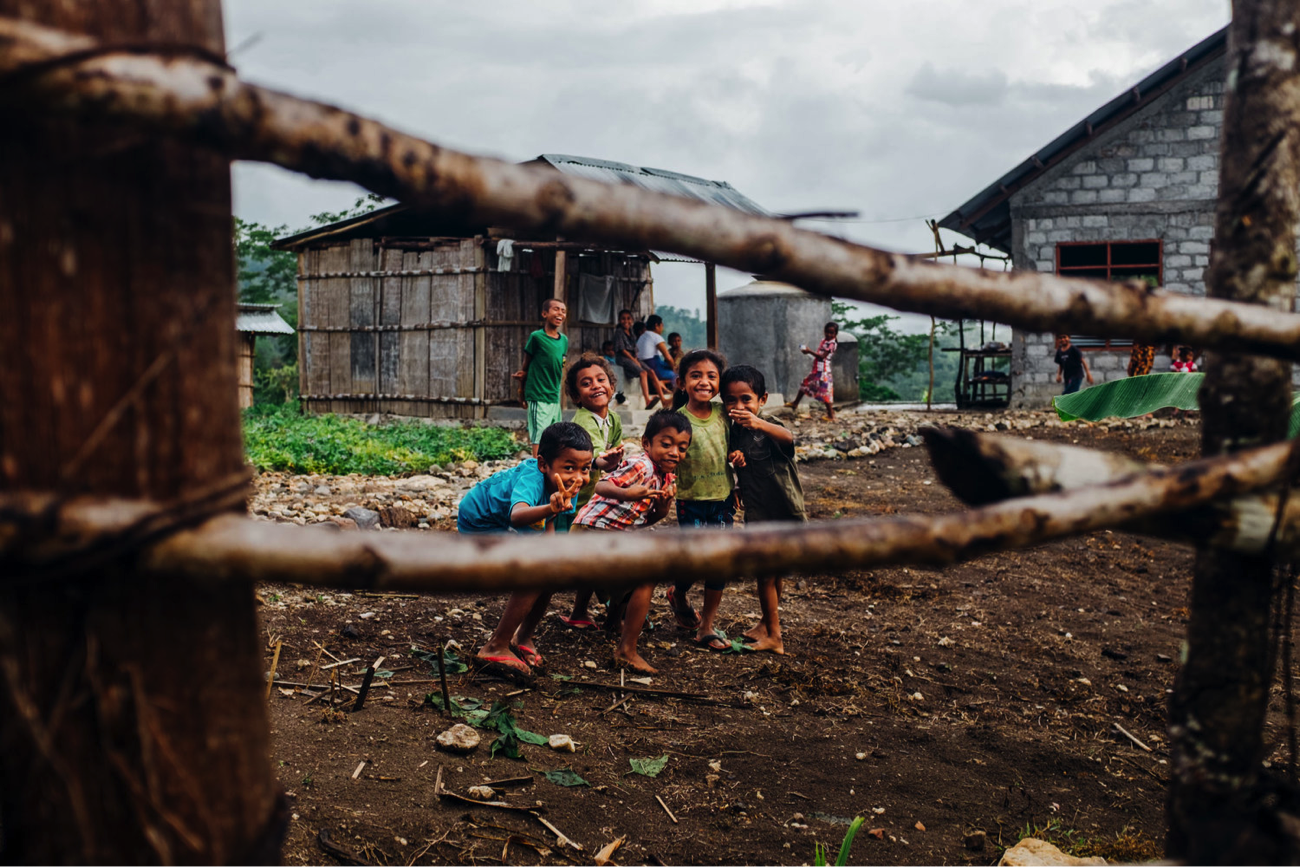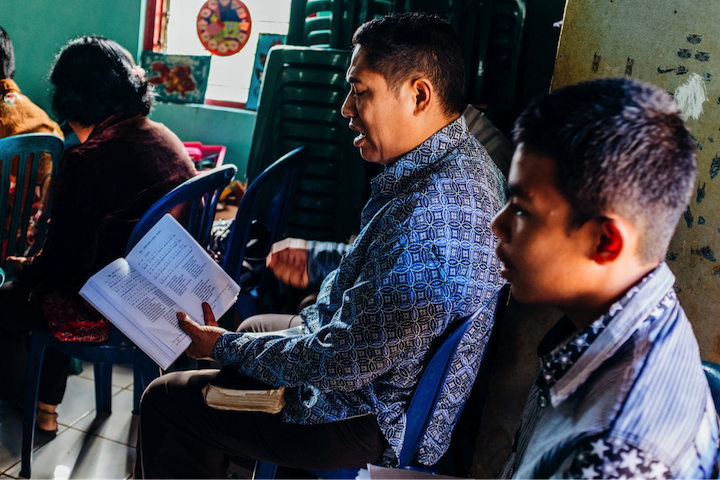
Over the past two years I have had the opportunity to take two media-focused mission trips abroad, one to Indonesia and the other to Thailand. In both locations I was busy documenting, through photography and video, the work being done in multiple fields throughout various villages. After returning from my latest trip the questions I keep asking myself are these: what is the purpose of the content I create, and whom does it serve?
I've come to believe that creating connections through stories about individuals in our mission congregations is where the focus of mission content creation should be. I want to answer these questions: "Why is storytelling essential for mission content?" "Who are those stories about?" "What do those stories actually look like?"
Story Is King
Storytelling is an integral part of the human experience. It's the way Christ communicated to us through parables, and it's how we like to spend our free time, engrossed in movies, television, and books. Telling stories is also one of the most effective ways to communicate a message to an audience.
Seth Godin, a best selling marketing author, was quoted saying, "Marketing is no longer about the stuff that you make, but about the stories you tell." So how does storytelling help world missions?

We have mission fields all over the world, and people who are a part of those missions lead drastically different lives from our own. Telling great stories is a way to bridge that cultural and geographic gap. A well-told story can transform a mission from an idea or a budget item into a tangible relatable experience. Without these stories we cannot expect the people back in our home congregations to have any deep emotional connection with their fellow brothers and sisters in Christ across the globe. It is also those stories and deeper connections that can lead to more support for our missions.
The next step in our storytelling has to be getting away from content that is essentially b-roll footage and talking heads describing the mission work, something I too am guilty of making. Instead a shift to a more point-of-view-focused and narrative-type of content is where we should be looking. By doing so we move away from keeping the subject at arm's length and hearing it described second-hand, to getting a more intimate look at the lives impacted by the mission work. If we were to make that kind of content whose stories would we tell?
Point of View
There are two major subjects we could focus on, the first being the missionaries and lay workers in the field. These perspectives are more relatable and often easier to follow due to logistics. For example, Sarah from your church is going to Africa to help in their outreach program. She will spend two weeks overseas working in the mission and the organization is documenting her experience along the way.

Sarah — she is our protagonist — will meet families the mission is serving and spend personal time with them. We could experience mission work vicariously through Sarah in a short video — think Anthony Bourdain: Parts Unknown. Done well, we can get a glimpse into the lives, culture, and religious practices of Lutherans across the world as well as the work being done in the mission. From her first interaction with a small child in the village to spending time in the child's home with their family, we could get a very clear picture of life around the mission. Tied up in a neat little bow everything could come back to the mission, the support they need, and how that serves these people we've just met.
There is, however, another point of view to focus on, that of our fellow believers whom our missions serve. While Sarah's story is good, we are seeing the mission through the eyes of someone more like ourselves, but the power of filmmaking is in its ability to place the viewer into the lives of others drastically different from their own.
Let's imagine we're at a church in a small Thai village where a mission has set up a medical clinic. The story begins with our protagonist, a thirteen-year-old girl by the name of Malee. Our journey through the perspective of Malee will take us two days, one way, as we follow her and her family to the only medical aid they’ll have access to all year. It is also one of the few times they have an opportunity to interact with a Lutheran pastor. We can then hear, in her own words, Malee talk with her family about the journey, the nurses and assistants, and the church. By making the people whom the mission serves the portal through which we see the work, we remove a layer of separation, and removing this layer through storytelling creates an opportunity for stronger connections with our congregations back home, connections that can lead to more support through compassion and empathy and not sympathy. If we focus on these types of stories and content what do the end products look like?

Media and Platforms
Video is the emphasis of most content these days and for good reason; it outranks every other type of medium when it comes to retention and views. So what does that mean for our stories?
Video should not be the only emphasis, but it is key. Great written blog content is still valuable for SEO [search engine optimization] on websites and it serves a different purpose. Blog writing has the opportunity to show a more nuanced perspective or side story in a mission field. Sarah may have had an incredible experience meeting someone at the local market or eating a new food, but it didn't fit into the short video. This is where a blog can shine. Images, stories, and even vlog style videos are perfect for additional content that helps shape the bigger picture. This type of material is not exactly front-page-worthy on a website, but it's absolutely integral for creating a complete picture. A great example of this type of content can be found on Charity: Water's blog. text https://blog.charitywater.org
Photography also has a place in shaping these stories. As long as Facebook and websites are still the main entry point for an audience, great images are necessary. Again our photographs should tell the stories of those impacted by the mission and help to clarify the goals and messages unique to each. Charity Water, for example, has very specific imagery for their website and the goal of those images, along with the design, is to help you quickly and clearly understand their purpose. They also share images that never appear on their website through platforms like Instagram, and these photos are accompanied by stories about the subjects depicted — one more example of creating content to build a bigger narrative around the organization through the perspective of those living there.

When it comes to video every opportunity should be taken for making content from multiple perspectives and about whichever stories most need to be told. From highly produced documentary-style shorts to casual vlog videos showing daily routines, they all have potential for great impact across various platforms.
But finally, story is essential, and the story in any mission, regardless of geography, starts with a person. By focusing attention on the people in our mission fields we can break down barriers that we may not even realize exist.
Over the course of the next five years I will be working full-time for Christians Forward, a Lutheran mission focused on medical relief. My job will be to implement these ideas on storytelling with the goal of growing a donor base and through that a stronger mission. My hopes are that I can gain experience first-hand on the efforts needed to craft an impactful narrative as well as create opportunities for others to do the same.
[ You can view some of Ben's work on his website and on Instagram. ]
Return to original language with "show original" button at top left.

Discussion
I also found it interesting how both you and I wrote about point of view. Just an observation...
I thought the same thing when I read yours! I think that means we're both on the right train of thought.
I highly enjoyed your thoughts on the use of photography, video, and blogs to further enhance the Gospel throughout the world. Your work is extremely important, since, as you said, “A well-told story can transform a mission from an idea or a budget item into a tangible relatable experience,” which can create a “deep emotional connection with their fellow brothers and sisters in Christ across the globe.”
In your “Point of View” paragraph, I fully support both the ideas expressed: those of the missionaries and lay people and those of the believers themselves. I was wondering in what situations would one of the views be more appropriate than the other, and would it be beneficial to combine the two views to create a story that both the congregation and fellow believers can relate?
Thank you for your insight to this topic!
Thank you for the kind words! I am happy to see that you took something away from the discussion and I hope you continue to think about the power of storytelling in any medium.
As for your questions, I do think there are times in which certain perspectives are better suited to tell a story. I don't think I could name a specific situation because I believe every story is unique and each mission each trip offers different opportunities. Telling a narrative from multiple viewpoints would also be not only beneficial, but I would say essential. A story about a volunteer or group of volunteers working on their first mission trip inner cut with the individuals in those mission fields offers a true cinematic storytelling experience. In cinema often times there are upwards of three to four narratives being told at a time not only to keep the viewer interested, but to paint a bigger picture of the story.
Thank you again for your comments!
What an amazing opportunity you must have had, traveling to missions and documenting those experiences! It is such a blessing to people like myself, who get to see the work of missions and missionaries through the lens of a photographer.
I appreciated your suggestions regarding the importance of point of view in a film. You stated that “by making the people whom the mission serves the portal through which we see the work, we remove a layer of separation, and removing this layer through storytelling creates an opportunity for stronger connections with our congregations back home.” I think this gives purpose to a film, because there is a specific goal in mind.
I had a few questions regarding items shared in your piece:
Is there a specific group of people you are hoping to target with your film and photography work?
You mention that Christians Forward is a non-profit organization. I was wondering if any of your 5 years of work with Christians Forward is paid for, or is this more of a volunteer program? Did that have any influence on your decision to join this project for 5 years?
Thank you for your contribution to the conference!
I am thrilled to know you are enjoying my work!
YOU are in fact a part of the group of individuals I am hoping to share my work with, among others. My work, however, is something that I do not approach while actively thinking about my audience. The image for me always comes first. I want to make beautiful images with people at the center. In this new position for Christians Forward part of my job will be to figure out who our audiences are, but more specifically who specific messages are crafted for. Realistically I think our audiences are anyone from the age of 12 to 99. Our stories will be made to reach anyone and everyone in a home congregation, but its the specific medium and story that will need to be tailored for the right audience. A vlog might not connect with an octogenarian in the same way a well made print magazine might not be something a teenager is interested in.
As for the new position itself it is in face paid for 5 years, due to a generous grant their received. That was in fact the deciding factor in me taking the position, however my initial involvement as a photographer in the mission fields was volunteer based. God works in wonderful ways! Thank you for your questions and your interest in my topic.
Thank you so much for your engaging article! I enjoyed hearing your thoughts on the use of visual media to connect Christians across countries and cultures.
One aspect of your article that really struck me was your take on point of view. When crafting a story, it is essential to have a clear perspective for the audience. While following the perspective of a missionary or volunteer is beneficial, it does not push the viewer out of his/her own comfort zone. However, if the story is told from the viewpoint of one of the recipients of our missions, it forces the viewer to think in different way. Seeing first-hand the experiences that people in other countries have can open the audience’s eyes to new ideas and ways of life. It also helps the viewer to be more empathetic -- creating an emotional connection between strangers who live distant places. In my experience, I have mostly heard from the missionary or the volunteer’s perspective. I would really enjoy seeing a film that portrays ministry from the alternative viewpoint.
I also liked your comments on photography. You said that one should share images that are “accompanied by stories about the subjects depicted.” This reminded me of a Facebook page called “Humans of New York.” This page posts pictures that examine the lives of random, ordinary people in New York and around the world, both through images and text. Do you think it would be plausible for the WELS and ELS to start a similar page (on Facebook or another social media avenue) that relates directly to mission work? Or, is there already something that fills this need?
Again, thank you for your article. It was a joy to see and read about your work. God’s blessings on your future endeavors!
Thank you for taking the time to look at my work and read my article.
Your comments and questions are directed at a topic I think about often. As a photographer first, I believe for an image to truly be great it needs to stand on its own. I don't feel the need to post information, background, stories, or anything more than location and year while sharing my work. However, with the work I will be doing for the mission field that changes things. These images no longer serve themselves, but they become a vehicle for storytelling and in order to do that well they must be accompanied by text, just like "Humans of New York". I could talk for ages about Brandon Stantons work and if it is the images or the text or some combination that brought him fame, but I'll save that for another time.
I think the idea of doing something similar for the ELS or WELS is interesting, but ultimately I think the individual organizations should be doing this as well. "Humans of New York" is all the proof you need that great and even simple stories accompanied by photos are enough to get people interested and invested on the simplest level. For me personally my failings start at my ability to interview and write. I love making the images, but I need practice writing the stories. Thank you again for your comments and I hope that you will follow my progress, especially when I start creating the work mentioned here.
I'm thrilled that you took the time to read my article! Thank you and I hope you continue to think about using stories to further the kingdom of God.
As for your questions! When it comes to sharing the mission field with our home congregations I always look at what is being done in the secular world. There is no need for us to reinvent the wheel, instead look at brands and organizations that get their content in front of their audience and keep people engaged. Examples would be vlogs that give an insight into the process bother abroad and at home. It may seem outdated but a beautiful quarterly magazine, and the key word here is beautiful. There are two brands that come to mind, Best Made Co. and Patagonia, they put out gorgeous print catalogs filled not just with product, but with stories. It's the attention to beauty of their magazines that keeps me from throwing them in the trash or canceling my subscription. Creating a beautiful magazine on missions will be a goal of mine within the next few years. Aside from creating more videos and beautiful magazines I think it's really just about being more narrative drive across all and any mediums. There isn't enough focus on stories. A story in any form be it a presentation, a magazine, or a video will always be the best way to capture an audience and grow a compassionate donor base.
As for where else I'd love to go. Everywhere. Really my dream would be to visit every single global mission by the time I die. I want to document all of it. Meeting the people, visiting their homes, eating their food and most importantly worshiping with them. I can't think of a better professional goal. Thank you for the questions!
I appreciate the work you are doing in this field. Your focus on utilizing media to tell a story is so important in our outreach ministry. Focusing on the story and moving away from what you call "b-roll footage and talking heads" is essential to this breaking down of barriers. I think this could be applied to all of our mission work, not just over seas. Even here in the states we have barriers that prevent us from effectively reaching out to those around us with the word of God. Hopefully, the outline you provide here can help guide others in their outreach work both at home and abroad. Thank you for sharing your work!
This concept never ceases to amaze me. The fact that we humans learn, communicate, and connect better when we suspend ourselves within a story is nothing short of mind-blowing. Christ gave us the dual commands of making disciples of all nations and doing everything we do to the best of our ability to his glory. I'd like to thank you, Ben, for realizing that this means we are to use any and all tools that God has seen fit to place at our disposal. We live in an age that fosters an unparalleled amount of connectivity and media; we can literally contact anyone in the world with minimal effort (when compared to all of history), a fact that many of us seem to overlook. God has granted us tremendous instruments of communication, the surface of which we have barely scratched. Ben, keep scratching.
As a final thought, I would like to ask your opinion on how those of us that have not and will not travel overseas can best use these tools of media and storytelling from our own homes. Nearly every one of us here stateside has access to a plethora of media platforms and resources, yet their potential goes largely unrealized every day as we sit around checking our email and immersing ourselves in books, movies and stories. The bottom line is this: what can we at home do to go from audience to storyteller?
Thanks again for your work, and God's blessings on your efforts.
Thank you for your passion for storytelling!
To answer your question, the best thing anyone can do to be involved in storytelling is support creators. As abundant as media is across countless platforms, there are also a huge number of avenues to support creators, things like Kickstarter for specific projects as well as Patreon for continued support. Funding the arts and storytelling is vital, it cannot survive or reach any real potential without funding. In a perfect work artists would work for "exposure" and because they just want to give back, but any artist or creator will tell you that it is more than a full time job to produce quality work consistently. Any organization creating content, that has proven to be compelling and worth sharing, understands the importance of creatives and the fact that people who have talents for creating these stories also deserve to be paid for their work.
The secular world has fully embraced this idea of funding the arts and creators. I kid you not there is a Knitting magazine that makes $19,000 per issue! PER ISSUE! https://www.patreon.com/knitty They do an issue a month. I have nothing against knitting, but imagine if we could find 3,000 people who cared that much about telling the stories of missions. $19,000 per month would go a long ways to supporting a group of creatives who's lives are dedicated to telling these stories (think of the historic impact of documenting these stories). That is honestly the best way for people to get involved. Take ownership over the fact that YOU can help create the content through funding it. Every month you could have a magazine or video or both that you get to enjoy not only because the stories are compelling, but because you know you helped make it happen.
I would love to write about this for next year's conference.
Thanks Sam!
First off, I really enjoyed reading your article and feel as if I can relate to some of my own personal experiences and storytelling regarding this topic. I like how you have a visual in your article to go along with video media and different points of view. Sometimes, I feel as if today people get to carried away with storytelling only being what you post on social media or certain uploaded pictures online and people commenting off of that. But really, they're missing the whole piece of the story and what went on. I'm in full agreement with you when you talk about storytelling and it being the most essential human experience. That's what makes any experience, trip, mission all about, the storytelling from your experiences. It brings people together, creates new effective ways to communicate, and most importantly it brings us closer to God knowing how blessed we really are and how his acts and works of kindness allow us to be in the position that we are today. Thank you for sharing your story with us.